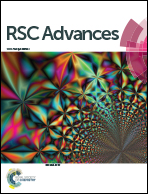New structural motifs in Mn cluster chemistry from the ketone/gem-diol and bis(gem-diol) forms of 2,6-di-(2-pyridylcarbonyl)pyridine: {Mn II4Mn III2} and {Mn II4Mn III6} complexes†
Abstract
The employment of the tripyridyl/diketone ligand 2,6-di-(2-pyridylcarbonyl)pyridine [(py)CO(py)CO(py)], in conjunction with azides (N3−), in Mn cluster chemistry has afforded the mixed-valence (II/III) complexes [MnII4MnIII2(N3)6Cl4(L1)2(DMF)4] (1) and [MnII4MnIII6O2(N3)12(L1)2(L2H)2(DMF)6] (2) in good yields. The resulting ligands L12− and L2H3− are the dianion and trianion of the ketone/gem-diol (L1H2) and bis(gem-diol) (L2H4) forms of (py)CO(py)CO(py), respectively, as derived from the metal-assisted hydrolysis of the parent dicarbonyl organic compound. Under the same synthetic conditions (i.e., reaction solvents, temperature and stirring time), the chemical identity of the two complexes was found to depend on the MnII starting material; in the presence of MnCl2, complex 1 is the only isolated product, while complex 2 can be only obtained if Mn(ClO4)2 is used. Complexes 1 and 2 are the second and third highest nuclearity products reported to date from any different form of coordinated ligands derived from (py)CO(py)CO(py). Magnetic susceptibility studies on both 1 and 2 revealed the presence of predominant antiferromagnetic exchange interactions between the metal centers. The combined results demonstrate the rich chemical reactivity of carbonyl groups and the ability of poly-ketone ligands to stabilize cluster compounds with unprecedented structural motifs and interesting molecular architectures.


 Please wait while we load your content...
Please wait while we load your content...